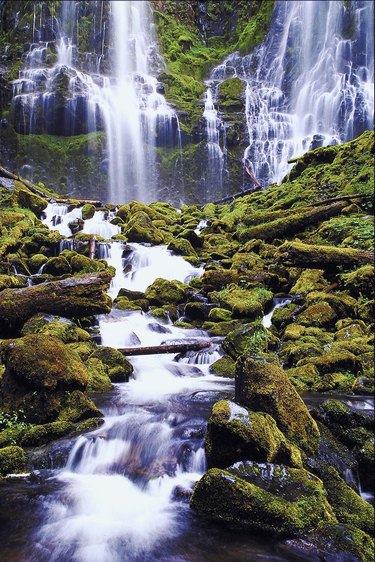
Although there are plenty of adequate moss killers available on the market, homemade moss killers can be just as effective. Moss is fairly harmless, but you may not want to see it growing in your garden. Not only can it be an eyesore, it can also take up valuable growing space in the soil. Get rid of moss with a homemade moss killer to maintain control of your garden.
Mixing the Moss Killer
Video of the Day
Homemade moss killer consists of four ingredients: water, vinegar, salt and soap. Add 1 gallon of warm water to a bucket. Add in 1 tablespoon of vinegar and 1 pound of salt. Add as much soap as you want, as long as it doesn't make up more than 20 percent of the total mixture. Each ingredient serves a purpose and must be mixed in the right ratio for the moss killer to be effective. The water is used as a diluter, which makes the application of the moss killer easier. The vinegar and salt draw moisture from the moss and kills it. Adding soap to the mixture helps the moss killer absorb into the moss more easily, which increases the chances of killing it.
Video of the Day
Application
Care must be taken when applying the homemade moss killer. Add the solution to a spray bottle and spray the affected areas. Spray enough solution on the moss to dampen it. The salt and vinegar in the mixture can be problematic. Neither ingredient is selective and will kill any plant it touches. Avoid spraying the solution onto flowers and plants, including fruits and vegetables you do not wish to get rid of. Give the solution a few days to work, as it takes time.
Lawn Maintenance
Once the moss has died, remove it immediately. Dig it up with a trowel or spade and discard it. Scrape dead moss from rocks and other hard formations with an abrasive sponge. After removing the moss, properly maintain your lawn and gardens to deter moss from growing again. Overseed bare areas of grass with a mixture of turftype ryegrasses or a ryegrass and fescue blend. Topdress the seeds with about ¼ of loose weed- and moss-free soil. Keep it moist until seedlings are formed. Moss requires moisture to grow, so maintain proper drainage in your lawn to avoid unnecessary pooling of water. Accumulation of water may lead to moss growth.
What is Moss?
What many people may not realize is that moss is a colony of tiny plants, not just one plant. Moss is flowerless and has weak stems. It requires plenty of water to grow and can be found in moist areas near ponds, puddles and drains. Although it is commonly known for its green color, moss also grows in various shades of brown. Various types of moss grow all over the world. According to Mountain Moss, there are around 10,000 varieties of moss worldwide.